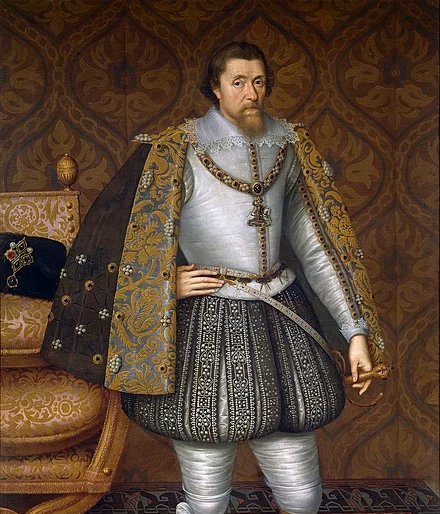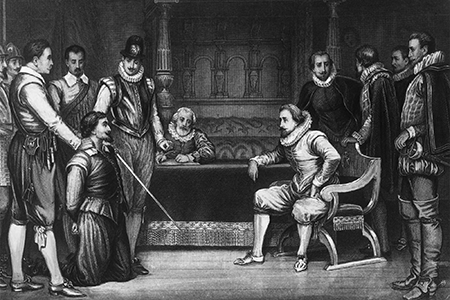



King James I – Quick Stats




Born: June 19, 1567
Union of the Crowns
In 1603, following the death of Queen Elizabeth I, James VI of Scotland ascended the English throne as James I, uniting the crowns of England and Scotland. His claim was based on his descent from Henry VII through his great-grandmother, Margaret Tudor.
In 1603, following the death of Queen Elizabeth I, James VI of Scotland ascended the English throne as James I, uniting the crowns of England and Scotland. His claim was based on his descent from Henry VII through his great-grandmother, Margaret Tudor.
King James I: The Scholar King Who United Thrones and Defied Conspiracies
His childhood was overshadowed by political instability, as regents vied for power, and he had to learn political maneuvering from an early age.
This belief often put him at odds with the English Parliament, leading to frequent disputes over taxation and royal prerogatives. He struggled to secure funds, and his reliance on unpopular financial schemes, such as selling monopolies and titles of nobility, further strained relations with Parliament.
James also pursued peace in foreign policy, striving to avoid costly wars. He ended England’s involvement in the Anglo-Spanish War and sought to marry his children into European royal families to strengthen diplomatic ties. However, his financial mismanagement and reliance on unpopular favorites, such as George Villiers, Duke of Buckingham, led to growing dissatisfaction among his subjects. His preference for peace over war was criticized by those who sought more aggressive action against Catholic powers in Europe, particularly during the Thirty Years' War.
Religious Conflicts and the Gunpowder Plot
Religious tension was a defining issue of James’s reign. While he was a Protestant, he initially showed tolerance toward Catholics. However, after several Catholic plots, including the infamous Gunpowder Plot of 1605—led by Guy Fawkes and other conspirators—James enforced stricter anti-Catholic laws.
Religious tension was a defining issue of James’s reign. While he was a Protestant, he initially showed tolerance toward Catholics. However, after several Catholic plots, including the infamous Gunpowder Plot of 1605—led by Guy Fawkes and other conspirators—James enforced stricter anti-Catholic laws.
Early Life and Ascension to the Throne
James Charles Stuart was born on June 19, 1567, at Edinburgh Castle in Scotland. He was the only child of Mary, Queen of Scots, and her second husband, Henry Stuart, Lord Darnley.
James Charles Stuart was born on June 19, 1567, at Edinburgh Castle in Scotland. He was the only child of Mary, Queen of Scots, and her second husband, Henry Stuart, Lord Darnley.
Died: March 27, 1625
Mother: Mary, Queen of Scots
Father: Henry Stuart, Lord Darnley
Wife: Anne of Denmark
Children: Henry Frederick, Prince of Wales
Charles I
One of his most significant achievements was the commissioning of the King James Bible in 1604. Completed in 1611, this translation remains one of the most influential and widely read versions of the Bible in the English-speaking world. James took a personal interest in the translation process, ensuring that it adhered to his theological and political beliefs.
His resistance to their demands led to their eventual migration to the New World, influencing the early colonial history of America. The early settlers of Plymouth Colony were among those discontented with James’s religious policies, seeking freedom to practice their faith in the Americas.
James was also deeply involved in philosophical and theological debates, writing works on monarchy and governance, including The True Law of Free Monarchies and Basilikon Doron, in which he laid out his vision of kingship. His writings provided an intellectual foundation for the concept of absolute monarchy, which would later contribute to the tensions leading to the English Civil War.
He died on March 27, 1625, at Theobalds House in Hertfordshire and was succeeded by his son, Charles I. His reign laid the groundwork for future conflicts between the monarchy and Parliament, which ultimately culminated in the English Civil War. His son’s inability to navigate these tensions would lead to his execution and the temporary abolition of the monarchy.
Conclusion
King James I's legacy is complex. While he is remembered for the King James Bible and his efforts to unite England and Scotland, his belief in absolute monarchy and conflicts with Parliament set the stage for political unrest. His rule was a pivotal period in British history, shaping the monarchy, religion, and culture in ways that still resonate today. Despite his flaws, he left a lasting impact on literature, theology, and governance, and his reign remains a crucial chapter in the history of both England and Scotland.
King James I's legacy is complex. While he is remembered for the King James Bible and his efforts to unite England and Scotland, his belief in absolute monarchy and conflicts with Parliament set the stage for political unrest. His rule was a pivotal period in British history, shaping the monarchy, religion, and culture in ways that still resonate today. Despite his flaws, he left a lasting impact on literature, theology, and governance, and his reign remains a crucial chapter in the history of both England and Scotland.
His birth was marked by political turmoil, and when James was just a year old, his mother was forced to abdicate the Scottish throne. As a result, James became King James VI of Scotland in 1567, with a series of regents ruling on his behalf during his minority.
James received a highly intellectual education under the tutelage of George Buchanan, a renowned scholar. His upbringing instilled in him a deep appreciation for literature, theology, and the divine right of kings, a belief that would influence his later rule over England and Scotland. Buchanan's rigorous teachings made James a learned monarch, fluent in multiple languages, including Latin, Greek, and French, and deeply involved in religious debates of the time.
Successor : Charles I
Predecessor : Elizabeth I
The unification of the two crowns marked the beginning of the Stuart dynasty in England, though the two nations remained legally separate. James strongly advocated for a closer union between England and Scotland, though he faced resistance from the English Parliament, which was reluctant to fully integrate the two kingdoms.
Elizabeth of Bohemia

James's rule was initially met with optimism, as many hoped his Scottish experience and Protestant faith would bring stability. However, his reign was also marked by challenges, including political conflicts and religious disputes. His court was known for its extravagance, and his generous patronage of favorites led to accusations of favoritism and corruption.
Governance and Policies
James strongly advocated for the divine right of kings, asserting that monarchs derived their authority directly from God rather than from Parliament or the people.
James strongly advocated for the divine right of kings, asserting that monarchs derived their authority directly from God rather than from Parliament or the people.

The failed attempt to assassinate him and blow up Parliament heightened Protestant fears and led to increased persecution of Catholics. The plot's discovery reinforced James's belief in the need for a strong, centralized monarchy to maintain stability.
James I interrogating Guy Fawkes after being captured
James also faced dissent from the Puritans, who sought further reforms in the Church of England. At the Hampton Court Conference of 1604, he rejected most Puritan demands, leading to continued dissatisfaction
Personal Life and Legacy
James married Anne of Denmark in 1589, and the couple had several children, though only three survived to adulthood: Henry Frederick, Prince of Wales (who died young), Charles (the future Charles I), and Elizabeth, who became Queen of Bohemia. His relationship with Anne was at times strained, particularly due to her Catholic sympathies, but the marriage endured despite occasional tensions.
James married Anne of Denmark in 1589, and the couple had several children, though only three survived to adulthood: Henry Frederick, Prince of Wales (who died young), Charles (the future Charles I), and Elizabeth, who became Queen of Bohemia. His relationship with Anne was at times strained, particularly due to her Catholic sympathies, but the marriage endured despite occasional tensions.
James was a patron of the arts and literature, supporting playwrights like William Shakespeare and Ben Jonson. Under his reign, the flourishing of English drama continued, and he took an active interest in theatrical productions. His court was known for its elaborate masques and cultural patronage. His interest in witchcraft and demonology also led him to write Daemonologie, a treatise on the subject, which influenced the infamous witch trials of the era. James believed that witchcraft posed a serious threat to his rule, and his reign saw an increase in witch hunts and executions.
Margaret Stuart
Sophia Stuart
Mary Stuart
Robert Stuart


